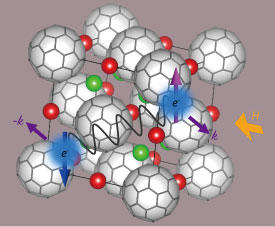

03/27/2017

© 2017 Kosmas Prassides
Most superconductors are made from metal atoms and usually achieve resistance-free electron transport at frigid temperatures. AIMR researchers and colleagues at the University of Tokyo and Kyoto University have now shown that switching to unorthodox ‘buckyball’ molecules can keep electrons superconducting under more practical conditions1.
Below a certain temperature, known as the critical temperature, electrons in superconductors experience strong attractions that cause them to pair up and transport charge without losing energy. However, this coupling can be disrupted by other forces, including external magnetic fields. This makes it tricky to incorporate superconducting elements into devices that operate at high fields or carry large electric currents, hence limiting their applications.
“The critical magnetic field reflects the pairing interactions in a superconductor — it shows how strong the glue is that keeps the electrons together,” explains Kosmas Prassides from the AIMR. “One of the holy grails of this field is to find a superconductor that is not affected by magnets at useful fields, regardless of which direction the field points in.”
Prassides and his co-workers recently discovered that hollow carbon spheres known as buckyballs (C60) may provide the answer. When synthesized into cubic crystals alongside cesium ions, C60 is an insulator. But by applying pressure to the crystal — either by using external anvil presses or by substituting atoms in its internal lattice — the material becomes superconducting. Balancing contributions to this state from C60 molecular distortions and the conductive crystal lattice produced the highest working temperature ever seen for a molecular superconductor.
Although theory predicts materials with high critical temperatures should resist magnetic fields, the team was taken aback at the magnitude of buckyball resilience — trials with a full complement of modern magnetic instruments could not decouple its electrons. Now, thanks to the powerful National High Magnetic Field Laboratory at Los Alamos in the US, the researchers have measured its direction-independent, critical magnetic field value: a record-setting 90 teslas, or nearly two million times the Earth’s magnetic field.
“Our glue was remarkable — it far exceeded our expectations,” says Prassides. “The strength comes from the electronic structure of the C60 molecule and how it cooperates with the electron correlations.”
Prassides notes that this mechanism enables fine-tuning of superconducting behavior using synthetic chemistry — a more promising way to increase the operating temperature than the conventional method based on substituting metal atoms. “A challenge for chemists is to design molecular materials to be the fundamental building units of a superconductor,” he says.
This research highlight has been approved by the authors of the original article and all information and data contained within has been provided by said authors.